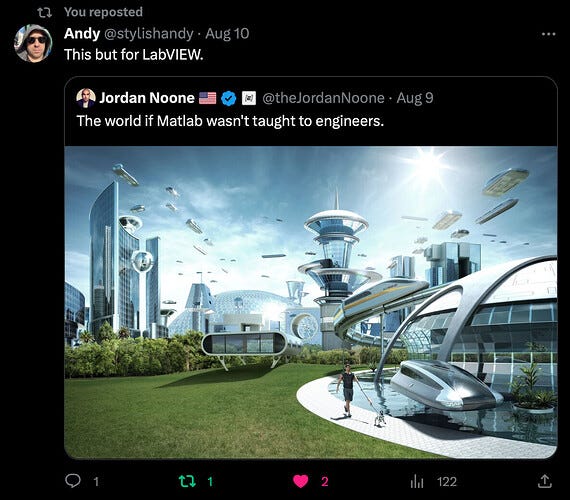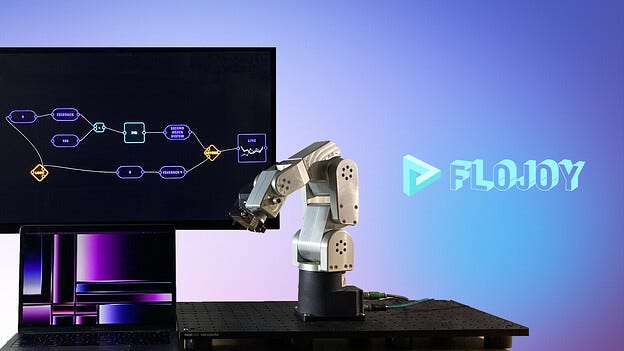Announcing Flojoy 🎉
Flojoy is the first open-source, Python-based app for test, measurement, and control
What is test, measurement, & control?
Test, measurement, and control (“TMC”) is the hardware-software UX that scientists and engineers use to measure and respond to data from the physical world.
To make this more concrete, envision the following examples of test, measurement and control software:
A computer-controlled microscope that automates image capture and processing
A function generator that applies and records input/output voltages
Underwater or atmospheric sensors that measure CO2, pH, or oxygen levels
Medical research devices such as an X-ray or MRI machine
It’s not an exaggeration to say that TMC is the bedrock of every R&D “hard-tech” laboratory and enterprise. At their core, heavy industry and hard-tech titans like Hitachi, Ford, Boeing, SpaceX, Intel, ASML, and Medtronics are all essentially TMC enterprises.
In the past century, there would have been no advancements in applied science and manufacturing without test, measurement, and control software. The invention of the computer and its application to sensing and controlling the physical spaces around it has revolutionized R&D and manufacturing to an extent that it’s impossible to imagine any other way.
Why Flojoy?
Test, measurement, and control (TMC) has been fundamental to every R&D and manufacturing advancement of the past century. R&D or manufacturing without the assistance of computers, sensors, and robotics is unimaginable. Despite this, the software in TMC’s hardware-software interplay has stagnated for decades. I believe that this stagnation is hindering society’s ability to provide engineers with a first-class education and rapidly deploy innovative and timely hardware. I would go so far as to say that without a stepchange advancement, the current state of TMC software will prevent civilization from addressing its most existential R&D callings.
In particular, due to inherent advantages in collaboration, dev speed, and performance, the interrelated software trends of Python, open-source, and AI have permeated every corner of STEM (“Science, Technology, Engineering, & Math”) in both academia and industry. However, this trinity is glaringly absent in test, measurement, and control software. Indeed, TMC software is one of the few (if only) areas of scientific computing that does not yet have robust Python tooling and a critical-mass open-source community.
Today’s scientists and engineers deserve better. The stress and physical taxation in conducting laboratory experiments, meeting R&D deadlines, responding to peer reviews, and troubleshooting manufacturing lines can be massive. This stress on scientists and hardware engineers will only increase as society demands rapid deployment of cost-effective tech for carbon sequestration, grid electrification, oceans remediation, wildfire management, and general decarbonization. The software facilitating these “hardtech” endeavors will need to embrace every edge that Python, AI, and open-source software has to offer.
My last company, Plotly, played a role in the scientific computing modernization of the 2010s by making scientific data visualization free, interactive, Web-based, and exceptionally well documented. 10 years later, Plotly has been downloaded over 300 million times by STEM practitioners in every country of the world. Plotly made data visualization more accessible for aspiring scientists and more delightful for practicing ones. With Flojoy, we’ll settle for nothing less than this global scale of impact on TMC and robotics.
TMC, AI, and Robotics
The lack of overlap between test, measurement, and control (TMC) software and Python-based AI and analysis is especially puzzling because they are so complementary. Why do we use one set of (mostly proprietary) software for TMC, then switch to Python for the downstream analysis of this data?
TMC software collects and responds to data from the physical world; while AI software uses this data to apply and refine (ML) models for domain-specific mastery. It seems inevitable for this to all be done in a single (Python-based) pipeline.
Indeed, resourceful scientists and engineers are already applying foundation ML models in Python to TMC data. One wildly successful example is the application of deep learning and object identification to microscopy and medical imaging. This is just the beginning. As platforms like Flojoy make Python-based AI accessible to an even broader community of non-coding scientists and engineers, every STEM practitioner will incorporate AI in their R&D.
Python, open-source, and AI are inevitable advancements in the field of test, measurement, and control. Indeed, TMC is one of the last scientific computing holdouts to not embrace Python and open-source. Advancements like Flojoy and GPT-assisted Python composition are already making instrumentation and robotics control in Python vastly more accessible. Consider these trends with the seemingly unstoppable rise of Python in STEM -it’s hard to imagine a world in 2030 where nearly all new R&D hardware control is not predominantly Python-based.
$1.3M in seed funding
To catalyze this transition, we’re proud to have partnered with BDC Capital’s $200M DeepTech Fund, Boreal Ventures, Flybridge Capital Partners, and a US aircraft manufacturer. Together, we’re breaking ground today on the open-source and AI-enabled future of TMC. Read more about this fundraise in TechCrunch.
Come join us
If this letter resonates with you, please consider joining us to breathe new life into the test, measurement, and control industry! Here are a few places that you can catch our attention:
If you work in R&D, support our work with a Workstation license



